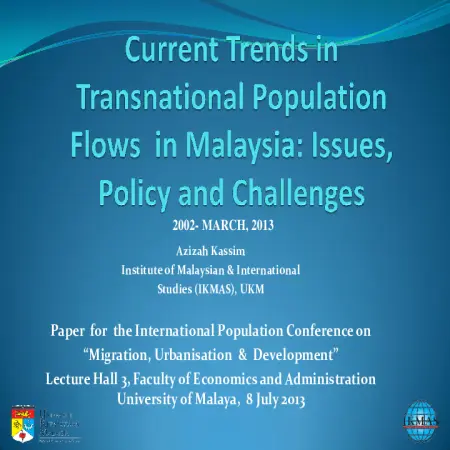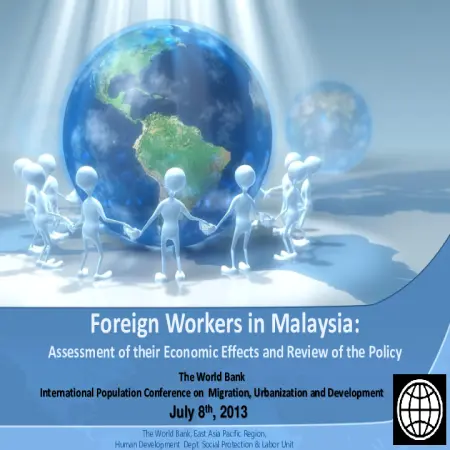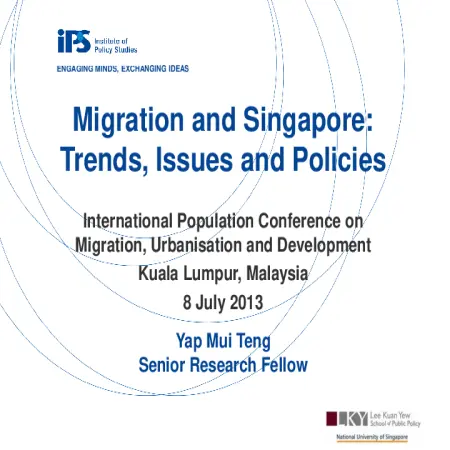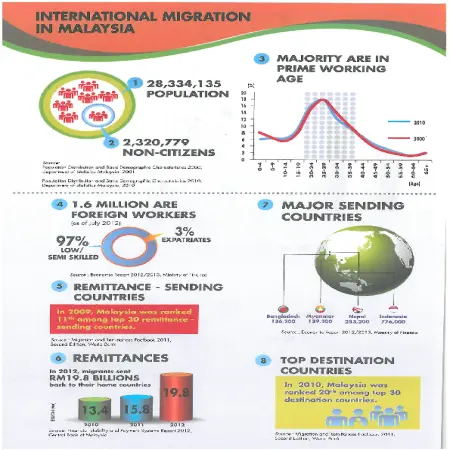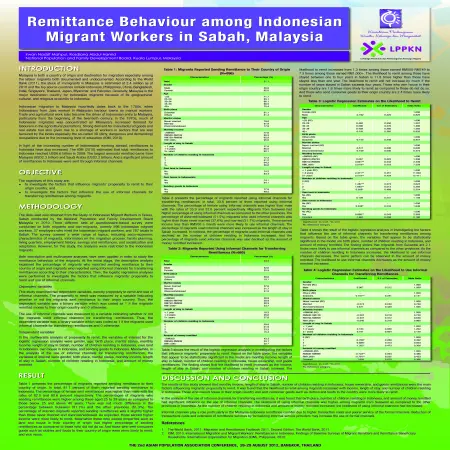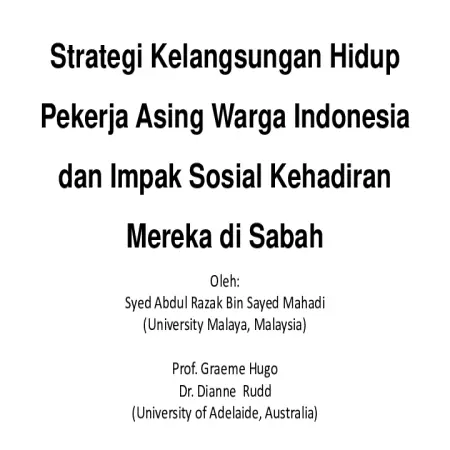TOPICS
Results for Topics : "Migration"
|
|
Current trends in transnational population flows in Malaysia: Issues, policy and challenges
Item Type: Conference or Workshop Item
Editor:
Year: 00/00/2013
Abstract: In the last 40 years there has seen a substantial increase in Malaysia’s foreign pop. According to the last National Census in 2010, out of a pop of 28.4 million, over 8.3% are non-citizens. The increase is mainly the result of labour inflow since the early 1970s due to Malaysia’s relatively better economic development and political stability which attract economic migrants and asylum seekers from within and outside the ASEAN region. This paper which focuses on current transnational flows in the country has the following objectives: 1. To provide an overview of transnational population flows in Malaysia in the last decade and identify major streams that are causing considerable concern to the state and the Malaysian public. The focus is on the low skill foreign workers, the largest category of migrants in Malaysia. 2. To examine public perceptions of foreign workers, how such perceptions are formed and what their impacts are on state policy. 3. To discuss the state policy on foreign workers, both legal and irregular, the objective of the policy and its strategies. 4. To highlight the challenges faced by the state in implementing the foreign worker policy. 5. To evaluate the achievement and shortcomings of the policy. The writer identifies five types of transnational inflows into Malaysia i.e. that of low skill migrant workers both legal and irregular; asylum seekers; expatriates; foreign students; and participants of Malaysia’s My Second Home (MM2H) project.
|
|
|
|
|
|
Internal migration and socio-demographic changes in Malaysia
Item Type: Conference or Workshop Item
Editor:
Year: 00/00/2013
Abstract: This paper re-examines the levels, trends and patterns of internal migration, followed by some discussions on the causes and consequences of internal migration in Malaysia in 1991 and 2000. A more up to date analysis awaits the release of migration data from the 2010 census. The focus of this paper is on inter-state and inter-regional rather than intra-state migration as more people moved across states than within state. Key questions to be addressed include the reasons for the high concentration of migration in the Klang Valley since the 1970s, migration selectivity in terms of age, education and ethnicity. The migration impact on socio-demographic changes and policy issues will also be examined.
|
|
|
|
|
|
Foreign workers in Malaysia: assessment of their economic effects and review of the policy
Item Type: Conference or Workshop Item
Editor:
Year: 00/00/2013
Abstract: This study aims to help Ministry of Human Resource to better manage existing human resources in the country and to plan for the development of future human capital needs.
|
|
|
|
|
|
The impact of Indonesian migrants from the locals' perception: a study in Sabah, Malaysia
Item Type: Scientific Poster
Editor:
Year: 00/08/2012
Abstract: Being a developed country, Malaysia has been receiving a large number of labour migrants from other neighboring countries. Statistics show that the total number of non-Malaysians in 2010 is 2.3 million compared to 1.3 million in the year 2000. It is over 8 percent of the total population in Malaysia and comprises mostly of Indonesian migrants. This phenomena has a great impact on Malaysia and its people. The objective of this study is to determine the impact of Indonesian migrants from the locals' perception and also to determine if gender, ethnicity, religion, marital status, educational level, job industry and monthly income make a difference in their perception. The data used for this study were obtained from the Study on Indonesian Migrants in Tawau, Sabah conducted by the National Population and Family Development Board (NPFDB) Malaysia in 2010. The survey managed to obtain information from 787 locals in Tawau. The dependent variable is the overall perception of the locals on the impact of the Indonesian migrants while the independent variables are gender, ethnicity, religion, marital status, educational level, job industry and monthly income. Independent t-test and analysis of variances (ANOVA) were applied to the data set. As a result, this study indicates that the locals in Tawau feel that the presence of the Indonesian migrants does have an effect on them. The mean score obtained was 95.053 out of a total of 135. The results of ANOVA showed that ethnicity (F = 6.950, df = 7), marital status (F = 12.320, df = 3), education level (F = 4.058, df = 7), job industry (F = 27.374, df = 3), and monthly income (F = 15.201, df = 6) contributed to the differences in the locals' perception on the impact of Indonesian migrants. Only gender and religion does not affect their perception. Thus, the entrance of Indonesian workers needs to be monitored as their presence are affecting the locals.
|
|
|
|
|
|
Remittance behaviour among Indonesian migrant workers in Sabah, Malaysia
Item Type: Scientific Poster
Editor:
Year: 00/08/2012
Abstract: Malaysia is both a country of origin and destination for migration especially among the labour migrants both documented and undocumented. According to The World Bank's Migration and Remittances Factbook 2011, the stock of immigrants in Malaysia is estimated at 2.4 million as at 2010 and the top source countries include Indonesia, Philippines, China, Bangladesh, India, Singapore, Thailand, Japan, Myanmar, and Pakistan. Generally, Malaysia is the major destination country for Indonesian migrants because of its geographical, cultural, and religous proximity to Indonesia.
The objective of this study is to investigate remittance behaviour among Indonesian migrants including the decision to remit and use of informal methods of transferring remittance. The data used was obtained from the Study of Indonesian Migrant Workers in Tawau, Sabah conducted by the National Population and Family Development Board Malaysia in 2010. Three different sets of questionnaire-based survey were conducted on both migrants and non-migrants, namely 896 Indonesian migrant workers, 37 employers who hired the Indonesian migrant workers, and 787 locals in Sabah. Both descriptive and multivariate analyses have been applied in order to study the remittance behaviour of the migrants. At the initial stage, the descriptive analysis explained the percentage of migrants who send remittance and migrants who use informal channels according to their characteristics. Then, logistic regression analysis was performed to investigate the factors that influence migrants' decision to send remittance and the use of informal methods of transferring remittance. The results of this study showed that age, monthly income, number of children residing in Indonesia, having own house in Indonesia and sending goods to Indonesia are the main factors contributing to the migrants' decision to remit. It was found that the likelihood to remit among migrants increased with age, income and number of children residing in Indonesia. Those who own house in their origin country and sending goods to the country are more likely to remit. In the analysis of methods of transferring remittance, it was found that birth place, number of children residing in Indonesia and the total amount of money remitted have significant relationship with the use of informal channels. The likelihood of using informal channels is higher among migrants from Sulawesi as compared to the other parts of Indonesia. As the number of children residing in Indonesia and amount of money remitted increased, the likelihood of using informal channels had decreased.
|
|
|
|
|
|
Strategi kelangsungan hidup pekerja asing warga Indonesia dan implikasi sosial akibat kehadiran mereka di Sabah
Item Type: Conference or Workshop Item
Editor:
Year: 00/00/2012
Abstract: Sabah's direction focuses on the development of 3 main sectors such as agriculture, tourism and manufacturing to drive the economy. As an agro -economy -based state, the 2010 census recorded 30 per cent of the total workforce engaged in the agricultural sector. As locals are not interested in seizing employment opportunities in the 3D -based agriculture and plantation sector (Difficult, Dirty & Dangerous), job vacancies are filled mainly by Indonesian workers as shown in data obtained from Temporary Work Visit Passes (TWVP). Certainly, their presence has social implications for the state of Sabah which housed 27.7 percent of the foreign population in 2010. Therefore, a micro study needs to be conducted to understand and analyze this situation. A joint study was conducted with NPFDB, in which a total of 896 respondents consisting of Indonesian workers from the plantation, manufacturing, construction, services and informal sectors were interviewed in a survey in the Tawau Division in 2010. In addition, primary data were also collected from interviews. Conducted among legal and illegal employees as well as based on the researcher’s observations. Interviews with government officials directly involved with the management and recruitment of foreign workers were also conducted. Secondary data were obtained from various government agencies in Sabah such as the Immigration Department, Manpower Department, Statistics Department, Health Department and Education Department. This study successfully identified 5 survival strategies that are often used by Indonesian workers to ensure the success of their migration, namely family networking, choice of residence, cultural adaptation and assimilation, economic survival and involvement in social and political institutions. Of course, the implementation of this strategy has a social impact on the local people. Important findings of this study show that most Indonesian workers come to Sabah with family members. Certainly the presence of spouses and children has huge implications for social facilities especially health and education. Therefore, there must be integration between the entry of foreign workers with Sabah's development planning, especially if the dependence on foreign labor continues until Sabah achieves the status of a technology - intensive economy in the future.
|
|
|
|
|
|
Indonesian labour migration to Sabah: causes and implications
Item Type: Conference or Workshop Item
Editor:
Year: 01/07/2011
Abstract: There is increasing interest among policymakers and researchers in the relationship between migration and development in low and middle income countries (United Nations, 2006). However, there remains a lack of empirical evidence on the impact of migration on economies of origin and destination, especially in Asia and Africa. This paper reports on one of the most substantial global migration corridors (World Bank, 2011) – that linking Indonesia and Malaysia. In 2009 it is estimated that migrants in Malaysia numbered 2 million, around a half of whom were Indonesians. It is based predominantly on a substantial survey of Indonesian labour migrants working in the East Malaysian state of Sabah undertaken in 2010. The paper begins with a brief discussion of contemporary thinking on the relationship between migration and development as a basis for examining the situation in Sabah. Some key features of the movement between Indonesia and Malaysia, especially that directed to Sabah, are then discussed. The economic contribution of Indonesian migrant workers is first examined in Sabah and then in the home areas of the Indonesian migrant workers. The paper then discusses the policy implications of these findings, especially in the Malaysian context.
|
|
|
|
|
|
Kajian pekerja Indonesia di Bahagian Tawau, Sabah: rumusan dan cadangan hasil kajian
Item Type: Conference or Workshop Item
Editor:
Year: 00/00/2011
Abstract: There are several factors for the entry of Indonesian workers to Sabah, among them is finding a job, earn a higher income as well as proximity to the country of origin. Recommendations and measures to be taken are to improve the enforcement of existing policies and laws, for example not being allowed to bring family members for unskilled and semi-skilled workers, prompt repatriation for foreign workers staying beyond the period (5 years) and employers bearing the cost of delivery come back. The next step is to curb the entry of illegal workers or immigrants, especially through illegal entrances (border control). Employers need to give priority to locals to work by giving higher wage rates or salaries. The government needs to set a minimum wage in every employment sector and plan workforce requirements updated. The government needs to encourage employers to move to mechanization and automation, especially for the plantation sector to reduce dependence on labor (unskilled and semi -skilled). Lastly, government should provide guidelines for the residence of foreign workers and facilities in the workplace as well as undergo regular monitoring by relevant agencies, and also encourage socialization with local residents. This presentation slide will describe the issues and suggestions that need to be taken as a result of the study of Indonesian workers in the Tawau Division, Sabah.
|
|
|
|





